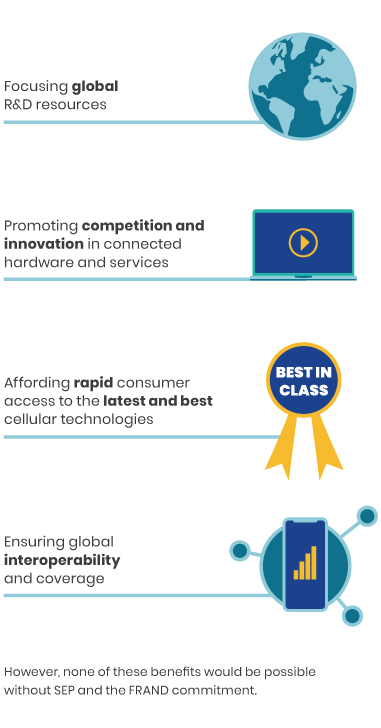Standard-Essential Patents (SEPs) enable modern digital society and life.
You find SEPs in cellular phones and connected cars, including every ambulance and police car. Every Internet of Things device that creates or connects to a cellular or WiFi network uses them, even windmills and solar farms. So does any device that uses wireless charging. You can’t see SEPs, but most modern digital electronic devices could not work without them.
First, a little bit of context about the connection between open standards and standard-essential patents.
Cellular phones, smartphones and other mobile, wirelessly connected devices would not work without cellular communication standards. These devices enable mobile communication through their use of a complex radio system to transmit data between connected devices across the cellular communication network and even some satellites.
Sometimes called “open” standards, these are massively detailed documents created by standards development organisations. For cellular connections, they define every aspect of how a cellular network operates and how connected devices work within it. Standards organisations such as ETSI continuously improve these standards to bring people better connections and new features with each new iteration, from 1G to 5G.

Cellular communication and digital audio and video streaming standards created opportunities for the development of new digital services and vast new marketplaces. These include mobile health services, streaming services, video-conferencing and the whole app ecosystem.
What are the benefits of open standards?
Such standards are generally developed through an open, collaborative technology development process. This model has four major benefits that have enabled rapid advances in communications technology, device connectivity, and digital services. These are:

However, none of these benefits would be possible without SEPs and FRAND.
What is a SEP?
A SEP is a standard-essential patent, or a patent that protects a specific technology selected for use in a standard. When you can’t implement a technical standard without using a certain patent, it is an “essential” patent, or SEP. In exchange, SEP owners need to make their SEPs available under “Fair, Reasonable and Non-Discriminatory” (FRAND) terms and conditions.
The FRAND principle is carefully balanced to ensure that both technology developers and implementers share the benefits of standardisation. It guarantees a fair return on investment to the inventors of cutting-edge technologies such as 5G, WiFi and video streaming. These technologies cost millions of euros to develop, and inventors voluntarily contributed them to the standardisation process. It also ensures that connected hardware manufacturers have access to the “open” standard on a reasonable and non-discriminatory basis. FRAND licensing facilitates the widespread use of the standard. It also ensures that each SEP owner gets a return on the results of its R&D without gaining an unfair bargaining position.

Why are SEPs vital to the functioning of open standards?
The system of open standards development needs to pass two key tests for all stakeholders to consider it sustainable.
Firstly, most world-leading research and development intensive organisations, including companies, universities, and public research organisations, need to make a fair return on investment (ROI). They take sizable financial risks to invent cutting-edge new technologies for standards. Standards organisations reject many of these for use in a standard, but the breadth and intensity of invention, together with competition, are responsible for the extraordinary rate of technical progress we have seen to-date. To continue to invest in innovation in cellular, WiFi and other communications technologies, these organisations need to have confidence that there is enough potential ROI available from SEP licensing to justify further investment. SEP owners need the confidence that those who use the technology will pay them fair and reasonable compensation if their technology is included in a standard.
Secondly, connected hardware manufacturers that use (or ‘implement’) the technology of open standards in their products need to know that SEP owners will not later arbitrarily block them from using one of the many patented technologies in a standard, or charge them a price which they consider unreasonable or discriminatory in relation to similarly situated implementers. Implementers need to be able to access all the patented technology included in the standard to ensure that they can fully comply with the technical specifications and provide seamless products and services to end-users.
The carefully balanced system of FRAND licensing of SEPs provides the greatest possible benefits to device and network makers, consumers, and the inventors of telecommunication technologies alike. The alternative would be a fragmented set of competing proprietary technologies that a few gatekeepers exclusively own and use.

For some practical examples of standard-essential patents in action, you might also be interested in these articles on our blog:
- What has a standard-essential patent done for me lately, anyway?
- How patents help deliver a great digital music experience
- Did you know that patents power video streaming?
- How patents are helping drive the green revolution
- 5G cellular standards enable smart factories
- How much is connected mobility worth?
